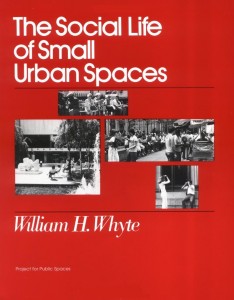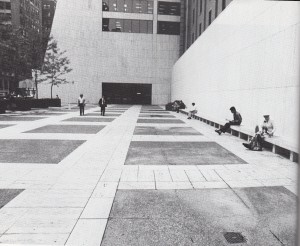William Whyte’s efforts to better design New York City’s public spaces have greatly influenced studies in urban planning and development.

As our studies took us nearer the center of New York, the imbalance in space use was even more apparent. Most of the crowding could be traced to a series of choke points—subway stations, in particular. In total, these spaces are only a fraction of downtown, but the number of people using them is so high, the experience so abysmal, that it colors our perception of the city around, out of all proportion to the space involved. The fact that there may be lots of empty space somewhere else little mitigates the discomfort. And there is a strong carry-over effect. …
We discovered that some plazas, especially at lunchtime, attracted a lot of people. One, the plaza of the Seagram Building, was the place that helped give the city the idea for the plaza bonus. Built in 1958, this austerely elegant area had not been planned as a people’s plaza, but that is what it became. On a good day, there would be a hundred and fifty people sitting, sunbathing, picnicking, and shmoozing—idly gossiping, talking “nothing talk.” People also liked 77 Water Street, known as “swingers’ plaza” because of the young crowd that populated it.
But on most plazas, we didn’t see many people. The plazas weren’t used for much except walking across. In the middle of the lunch hour on a beautiful, sunny day the number of people sitting on plazas averaged four per 1,000 square feet of space—an extraordinarily low figure for so dense a center. The tightest-knit CBD (central business district) anywhere contained a surprising amount of open space that was relatively empty and unused.

If places like Seagram’s and 77 Water Street could work so well, why not the others? The city was being had. For the millions of dollars of extra space it was handing out to builders, it had every right to demand much better plazas in return.
I put the question to the chairman of the City Planning Commission, Donald Elliott. As a matter of fact, I entrapped him into spending a weekend looking at time-lapse films of plaza use and nonuse. He felt that tougher zoning was in order. If we could find out why the good plazas worked and the bad ones didn’t, and come up with hard guidelines, we could have the basis of a new code. Since we could expect the proposals to be strongly contested, it would be important to document the case to a fare-thee-well. …
But zoning is certainly not the ideal way to achieve the better design of spaces. It ought to be done for its own sake. For economics alone, it makes sense. An enormous expenditure of design expertise, and of travertine and steel, went into the creation of the many really bum office-building plazas around the country. To what end? As this manual will detail, it is far easier, simpler to create spaces that work for people than those that do not— and a tremendous difference it can make to the life of a city.
Whyte, William H. 1980. The Social Life of Small Urban Spaces. New York: Project For Public Spaces, Inc. pp. 10-15. || Amazon || WorldCat
